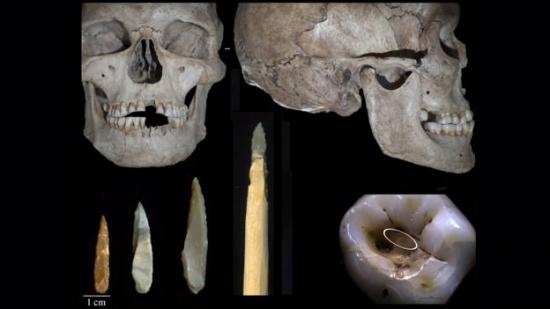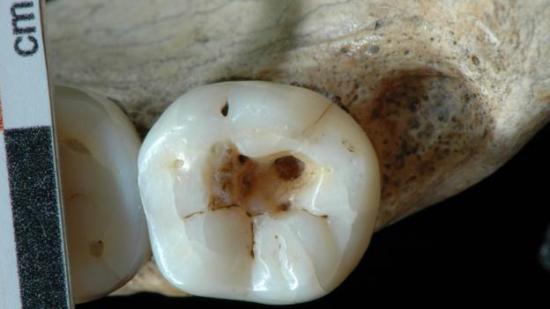Long before humans invented writing, the wheel and civilisation, they learned how to drill rotten teeth to relieve the pain of tooth decay
Colin Barras
Source - http://www.bbc.com/earth/story/20160229-how-our-ancestors-drilled-rotten-teeth
Imagine a world without toothbrushes, mouthwash and dental floss. That’s an easy one, right? There would be rotten teeth in every mouth, and rich dentists in every town.
The earliest prehistoric human ever found in Africa seemed to confirm as much. In 1921, miners working at Kabwe, or Broken Hill, in what is now Zambia, came across a primitive looking skull.
It had a sloping forehead, giant brow ridges and cavities in 10 of its teeth. The Broken Hill skull’s original owner, an adult male who belonged to our ancestor speciesHomo heidelbergensis, may even have died as a consequence of his poor oral health.
But here’s the surprise: the Broken Hill skull is a strange (and still largely unexplained) anomaly. Look into the mouths of most other early human fossils and you’ll rarely find a dental cavity. Strangely, for millions of years of human prehistory our ancestors were blessed with generally good oral health - even though their dental healthcare consisted of little more than the use of simple toothpicks.
In fact, rotten teeth only became a common problem very recently - about 10,000 years ago - at the dawn of the Neolithic period, a time when our ancestors began farming. Relatively sophisticated dentistry emerged soon after. In the last decade or so archaeologists have found evidence from cultures across the world that bad teeth were scraped, scoured, even drilled and filled apparently to remove decayed tissue.
Or, to put it another way, it looks like the dental drill predates writing, civilisation, and even the invention of the wheel by thousands of years.
Tooth decay is not entirely absent from pre-agricultural societies, but it’s very rare. “The frequency of caries among hunter-gatherers is roughly 1-5% and around 6-8% among populations with mixed subsistence strategies,” says Alejandra Ortiz at New York University. “This contrasts with agriculturalists, who show frequencies between 10% and up to 80-85%.”
The rise of rotten teeth was first recognised in the 1970s, says Marc Oxenham at the Australian National University, and relatively quickly archaeologists decided that it must be explained by the shift to carbohydrate-rich diets that came with farming.
“I guess the increasing clinical awareness - or marketing of the idea at least - that sugars are bad for teeth was also occurring at this time,” he says. “Many archaeologists made the seemingly logical leap that carbohydrates, in general, are bad for teeth.”
The idea does make some sense. Some oral bacteria, such asStreptococcus mutans, convert carbohydrates into enamel-destroying acids - and these species must have thrived in the mouths of early farmers. But Oxenham and some other researchers think that diet alone can’t explain why dental caries became so common worldwide.
“In regions such as Asia, where the dominant farmed crop is rice, the evidence for changes in oral health and the rise of agriculture is very messy,” says Oxenham. “Using a dietary model to explain oral health changes in Asia does not work very well at all.”
Instead, teeth may have suffered because of another change that farming brought: a massive increase in population size. Farmers tended to stay put rather than wander as their hunter-gatherer societies had done before them. They could usually rely on more predictable food supplies than their ancestors.
Both factors contributed to a rise in fertility rates. This was bad news for the oral health of women – for example, hormonal changes during pregnancy has known links to increased inflammation of the gums. It also leads to changes in the pH of saliva that make it less able to neutralise the acids associated with tooth decay
“I do still think that the influence that the Neolithic transition had on women’s health in general is still under-appreciated,” says James Watson at the Arizona State Museum, who has studied the link in the Americas.
There’s plenty of evidence that women’s oral health was worse than men’s in early farming societies, says Oxenham. “Our work has looked at ancient Asian communities and found a correlation between increased fertility and major declines in female oral health,” he says.
We don't know exactly how important these competing factors were in explaining why farming brought such a sudden and dramatic rise in the number of rotten teeth but what's clear is that prehistoric societies didn’t simply put up with the pain. They understandably began exploring ways to soothe sore mouths. And so they invented dentistry.
At the moment, the earliest potential evidence we have for therapeutic dentistry comes from just before the dawn of farming, at a time when pre-farming communities were already beginning to consume the sorts of carbohydrate-rich grains and starches that would later be farmed.
Last year, Stefano Benazzi at the University of Bologna, Italy, and his colleagues took a closer look at a 14,000-year-old adult male skull that was found on a dig in Italy in the late 1980s. They discovered signs that the biting surface of one rotten tooth in the jaw had been deliberately scoured and scraped with a tool - perhaps in an effort to remove the decayed tissue.
Under a microscope, the scratches on the tooth look similar to those that a finely crafted small flint blade - a “microlith” - might make. This tool technology was relatively new at the time.
 Early dentistry with these tools would have been painful (Credit: M Romandini).
Early dentistry with these tools would have been painful (Credit: M Romandini).
The improvement in tools like this could have spurred their use for rudimentary dental treatment, says Benazzi. The research team even experimented with modern teeth and similar sorts of microliths to confirm that these fine tools could have made such marks.
Whether this early dentistry really helped relieve the pain from rotting teeth is debatable - in the case of the 14,000-year-old Italian patient, the surgical procedure managed to remove only part of the decayed tissue. More effective treatment would only come a few thousand years later with the invention of better technology: the first dental drill.
We don’t know for sure where it was first invented, but some researchers believe it was being put to use in what is now Pakistan, between about 9,000 and 7,500 years ago. There, in a Neolithic graveyard, scientists discovered evidence that at least nine different individuals had gone under the drill. All of them had molars with precise holes - each just 1 to 3mm in diameter - bored into the biting surfaces. One individual had actually undergone the procedure three times on different teeth.
 This man visited his prehistoric dentist 14,000 years ago (Credit: Stefano Benazzi)
This man visited his prehistoric dentist 14,000 years ago (Credit: Stefano Benazzi)
Under a microscope the researchers found concentric ridges on the internal walls of some of the holes. They say these holes were not simply made by careful scraping but as a result of drilling.
It might seem remarkable that such ancient people could fashion a dental drill with basic materials, but it's a technology that still exists.
Some indigenous societies today carve holes in objects using a tool called a bow-drill. This consists of a few sticks of wood, a sharp stone, and a length of cord. The cord is tied to either end of one flexible stick, making it look like a small version of an archer’s bow.
The cord is then wrapped tightly around a second stick held perpendicular to the “bow”. By simply moving the bow back and forth, this second stick will rotate just as a drill does. Attaching a sharp stone to the end of this drill increases its cutting power.
To get an idea of whether a stone-tipped bow-drill could function in dentistry, the research team working in Pakistan constructed a bow-drill and attempted to drill holes in human enamel. The results were surprising; it took under a minute to drill holes of the kind seen in the 9,000-year-old teeth.
 Tools like this may have been used by ancient dentists (Credit: John angerson/Alamy)
Tools like this may have been used by ancient dentists (Credit: John angerson/Alamy)
Inevitably, though, there are still those who doubt that such early societies had the wherewithal to drill teeth. “There is still debate about whether bow-drilling was used in the Late Upper Paleolithic or [whether] holes were produce by percussion [hammering or scraping],” says Benazzi.
PART. 2